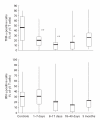The proportion of circulating gammadelta T cells increases after the first week of onset of tularaemia and remains elevated for more than a year
- PMID: 10792377
- PMCID: PMC1905656
- DOI: 10.1046/j.1365-2249.2000.01215.x
The proportion of circulating gammadelta T cells increases after the first week of onset of tularaemia and remains elevated for more than a year
Abstract
In various human intracellular bacterial diseases, an increase of the proportion of circulating Vgamma9Vdelta2 T cells has been observed. The prevalence of the finding among infected subjects and the time course of the elevation remain to be investigated. In the present study, comprising blood samples from a large number of cases of ulceroglandular tularaemia, the percentage of Vgamma9Vdelta2 T cells within the first week of onset of disease (5.3 +/- 0.7% (mean +/- s.e.m.)) did not differ from that of control subjects (5.3 +/- 0. 8%). Thereafter, percentages increased rapidly and within the interval of 8-40 days mean levels were > 20% (P < 0.001). Of 45 individuals sampled within 3 months of onset, 42 showed a percentage of Vgamma9Vdelta2 T cells of > 10%. Significantly increased levels were still recorded at 18 months (13.8 +/- 2.4%; P < 0.05) but not at 24 months (10.2 +/- 2.1%; P > 0.10). Thus, a consistent increase of circulating Vgamma9Vdelta2 T cells was demonstrated in tularaemia. The initial delay and the prolonged course of elevation may suggest a role in immunoregulation and/or immunological memory. Furthermore, the percentage of gammadelta T cells expressing tumour necrosis factor-alpha in response to phorbol myristate acetate was decreased during the first week and up to 40 days after onset, possibly reflecting the modulation of an inflammatory response.
Figures


Similar articles
-
V gamma 9V delta 2 T cells in human legionellosis.Clin Diagn Lab Immunol. 2001 Sep;8(5):949-54. doi: 10.1128/CDLI.8.5.949-954.2001. Clin Diagn Lab Immunol. 2001. PMID: 11527809 Free PMC article.
-
An abnormal phenotype of lung Vγ9Vδ2 T cells impairs their responsiveness in tuberculosis patients.Cell Immunol. 2013 Apr;282(2):106-12. doi: 10.1016/j.cellimm.2013.05.001. Epub 2013 May 15. Cell Immunol. 2013. PMID: 23770719
-
In vivo gammadelta T cell priming to mycobacterial antigens by primary Mycobacterium tuberculosis infection and exposure to nonpeptidic ligands.Mol Med. 1999 Jul;5(7):471-6. Mol Med. 1999. PMID: 10449808 Free PMC article.
-
Innate immune functions of human gammadelta T cells.Immunobiology. 2008;213(3-4):173-82. doi: 10.1016/j.imbio.2007.10.006. Epub 2007 Dec 3. Immunobiology. 2008. PMID: 18406365 Review.
-
Infrequent manifestations of tularaemia in Sweden.Scand J Infect Dis. 1997;29(5):443-6. doi: 10.3109/00365549709011851. Scand J Infect Dis. 1997. PMID: 9435029 Review.
Cited by
-
Characterization of lethal inhalational infection with Francisella tularensis in the common marmoset (Callithrix jacchus).J Med Microbiol. 2010 Sep;59(Pt 9):1107-1113. doi: 10.1099/jmm.0.020669-0. Epub 2010 Jun 17. J Med Microbiol. 2010. PMID: 20558585 Free PMC article.
-
Differential effects of tumour necrosis factor-alpha and interleukin-12 on isopentenyl pyrophosphate-stimulated interferon-gamma production by cord blood Vgamma9 T cells.Immunology. 2009 Jun;127(2):171-7. doi: 10.1111/j.1365-2567.2008.02983.x. Epub 2008 Nov 14. Immunology. 2009. PMID: 19019091 Free PMC article.
-
Gamma delta T cell expansion in Whipple's disease with muscular granulomatous vasculitis.Infection. 2018 Aug;46(4):573-576. doi: 10.1007/s15010-018-1143-3. Epub 2018 May 3. Infection. 2018. PMID: 29725938
-
Ex vivo restimulation of human PBMC expands a CD3+CD4-CD8- γδ+ T cell population that can confound the evaluation of CD4 and CD8 T cell responses to vaccination.Clin Dev Immunol. 2013;2013:186420. doi: 10.1155/2013/186420. Epub 2013 Aug 26. Clin Dev Immunol. 2013. PMID: 24066003 Free PMC article.
-
Human Peripheral Blood Gamma Delta T Cells: Report on a Series of Healthy Caucasian Portuguese Adults and Comprehensive Review of the Literature.Cells. 2020 Mar 16;9(3):729. doi: 10.3390/cells9030729. Cells. 2020. PMID: 32188103 Free PMC article. Review.
References
-
- Morita CT, Beckman EM, Bukowski JF, et al. Direct presentation of nonpeptide prenyl pyrophosphate antigens to human γδ T cells. Immunity. 1995;3:495–507. - PubMed
-
- Davis MM, Chien Y. Issues concerning the nature of antigen recognition by αβ and γδ T-cell receptors. Immunol Today. 1995;16:316–8. - PubMed
-
- Esin S, Shigematsu M, Nagai S, et al. Different percentages of peripheral blood γδ+ T cells in healthy individuals from different areas of the world. Scand J Immunol. 1996;43:593–6. - PubMed
-
- Ho M, Webster HK, Tongtawe P, et al. Increased γδ T cells in acute Plasmodium falciparum malaria. Immunol Letters. 1990;25:139–41. - PubMed
Publication types
MeSH terms
Substances
LinkOut - more resources
Full Text Sources

